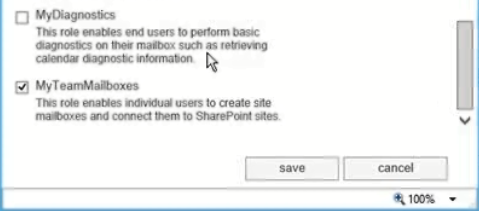the admin role concept
- 67 different admin roles and these vary in recipient and configuration scope
- roles are added to Role Groups
- 12 different built-in Admin role groups to choose from
Primary role group is Organization Management (Mailbox search role disabled by default)
Role groups are assigned roles and members are shown.
Organization Management role groups contains all roles except mailbox search and Administrators are a member
Additional roles and members can be added
Discovery Management has the Mailbox Search role assigned.
Although there are 67 default admin roles you can create additional ones or tweak the ones that exist
These roles are based on underlying PowerShell cmdlets and commands that are assigned
Use Exchange Management Shell to view information and alter information about roles
- Get-ManagementRole -Cmdlet New-Mailbox - shows management roles that has the ability to use new-mailbox cmdlet
- Get-ManagementRoleEntry "Public Folders\*" - shows what cmdlets and parameters makeup the public folder role
Get-ManagementRole -Cmdlet New-Mailbox
Get-ManagementRoleEntry "Public Folders\*"
User Roles" Role Assignment Policy
You can configure polices that grants end users permissions to set their Outlook Web App options and perform other self-administration tasks such as:
- modifying contact information
- view and modify distribution group membership
- view and modify marketplace apps
Default Role Assignment Policy
To apply the default role assignment policy, it is done in user mailbox , mailbox features settings.
Scenario
add use to discovery management role group
create a new role group that includes the roles
- mail recipient creation
- mail recipients
- recipients policies
- public folders
create a new role assignement polcy called Full Control that allows end-users complete self-administration control and apply to end users
Apply new Full Control policy to user mailbox.


















No comments:
Post a Comment